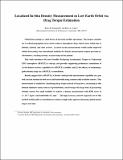| dc.contributor.author | Fitzgerald, Riley McCrea | |
| dc.contributor.author | Cahoy, Kerri | |
| dc.date.accessioned | 2021-05-11T15:14:32Z | |
| dc.date.available | 2021-05-11T15:14:32Z | |
| dc.date.issued | 2019-07 | |
| dc.date.submitted | 2019-03 | |
| dc.identifier.issn | 0022-4650 | |
| dc.identifier.issn | 1533-6794 | |
| dc.identifier.uri | https://hdl.handle.net/1721.1/130568 | |
| dc.description.abstract | Orbital forecasting is an essential part of precision satellite operations. The largest contributor to orbital propagation error in low orbits is atmospheric drag, which varies widely due to altitude, latitude, and solar activity. Accurate in-situ measurements would enable improved orbital forecasting, but conventional methods for density measurement require precision accelerometers, tracking systems, or processing on the ground. This work introduces the novel Satellite Producing Aerodynamic Torque to Understand LEO Atmosphere (SPATULA) concept, and provides supporting preliminary simulations of 1) the density recovery capability of a SPATULA satellite, and 2) the efficacy of estimating a global density map via a SPATULA constellation. Results suggest that a SPATULA CubeSat could provide measurement capability on par with current methods in both error and bandwidth using commercially available sensors. This measurement is enabled by considering drag torque instead of drag force; measuring in this domain eliminates many sources of perturbation, and leverages the large body of preexisting attitude sensors for small satellites to achieve a density measurement with root-mean-square error of 1 × 10⁻¹³ kg/m³ and bandwidth of 1 min⁻¹. The high accuracy and low expected cost of this method would enable a constellation to estimate a high-order spherical harmonic global density map in real time. | en_US |
| dc.language.iso | en | |
| dc.publisher | American Institute of Aeronautics and Astronautics (AIAA) | en_US |
| dc.relation.isversionof | http://dx.doi.org/10.2514/1.a34338 | en_US |
| dc.rights | Creative Commons Attribution-Noncommercial-Share Alike | en_US |
| dc.rights.uri | http://creativecommons.org/licenses/by-nc-sa/4.0/ | en_US |
| dc.source | Prof. Cahoy via Barbara Williams | en_US |
| dc.title | Localized In-Situ Density Measurement in Low Earth Orbit via Drag Torque Estimation | en_US |
| dc.type | Article | en_US |
| dc.identifier.citation | Fitzgerald, Riley M. and Kerry L. Cahoy. "Localized In-Situ Density Measurement in Low Earth Orbit via Drag Torque Estimation." Journal of Spacecraft and Rockets 56, 5 (September 2019): 1564-1579. © 2019 American Institute of Aeronautics and Astronautics, Inc | en_US |
| dc.contributor.department | Massachusetts Institute of Technology. Department of Aeronautics and Astronautics | en_US |
| dc.relation.journal | Journal of Spacecraft and Rockets | en_US |
| dc.eprint.version | Author's final manuscript | en_US |
| dc.type.uri | http://purl.org/eprint/type/JournalArticle | en_US |
| eprint.status | http://purl.org/eprint/status/PeerReviewed | en_US |
| dc.date.updated | 2021-05-07T15:36:56Z | |
| dspace.orderedauthors | Fitzgerald, RM; Cahoy, KL | en_US |
| dspace.date.submission | 2021-05-07T15:36:57Z | |
| mit.journal.volume | 56 | en_US |
| mit.journal.issue | 5 | en_US |
| mit.license | OPEN_ACCESS_POLICY | |
| mit.metadata.status | Complete | |
